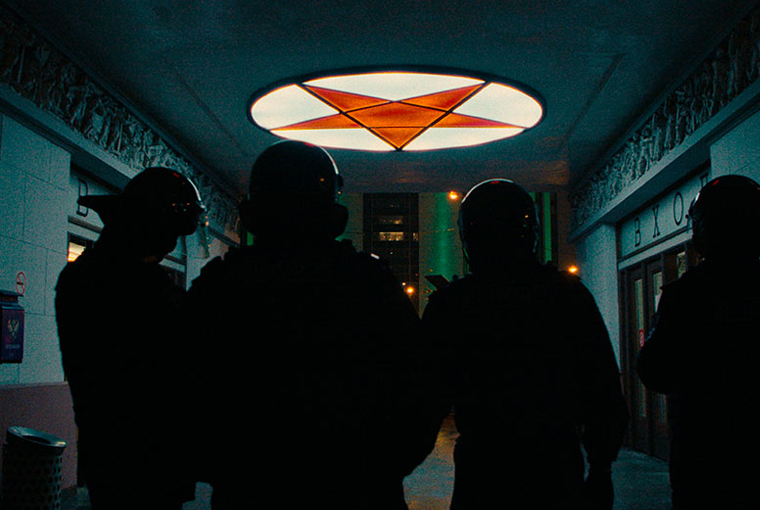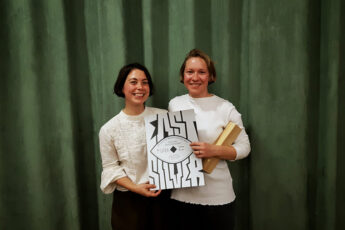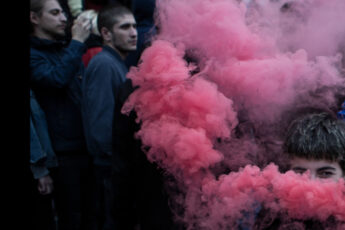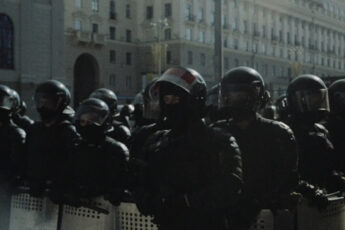Non-Places and Those Who Count for “Nothing”
Ruslan Fedotov’s Where Are We Headed? (2021)
Vol. 128 (October 2022) by Antonis Lagarias
No one could better summarize, in all its cynicism and social contempt, the true thoughts of the advocates of neoliberalism regarding the imbrications of the urban metropolis than Emmanuel Macron, president of the French Republic. In front of a crowd of entrepreneurs in 2017, the officeholder described train stations as “a place where one can see those who succeed and those who are nothing”,1 a slip of the tongue or an intentional clin d’œil to his allies that sparked waves of social anger and indignation. Nonetheless, the statement had but a minor impact on his political future, as evidenced by his recent reelection. Ideology and vocabulary aside, his statement can be recast as an anthropological remark that contrasts with Marc Augé’s popular theoretical conception of “non-places” that Augé had employed to designate urban transit spaces.2 Examining the growth of a city within a rapidly developing post-modern world, the French anthropologist defined “non-place” in 1992 as the antithesis to an “anthropological place”. If the latter is an identity-making space whose spatial arrangements produce a territorialized patrimonial identity within existing (and spatialized) history, culture and social habits, a non-place negates all identities and replaces them with the collectively shared identity of “the user”, “the passenger”, “the client”, and so forth.
To Augé, the proliferation of non-places marks the impact of what he calls supermodernity (surmodernité), a cosmopolitan and interconnected world marked by the acceleration of history, the excess of events and spaces, and by an individualization of references. Airports and motorways, commercial stores and hotels and notably urban train stations – once considered the emblem of the modern city – fall into the category of “non-places” as transit spaces that are characteristic of civic alienation in the ever-expanding modern cityscape. Irrespective of its architectural design (a station may be as impressive and historic as a palace), a non-place is arranged to address everyone at the same time, mostly through universally understood signs and written directions, creating a blend of sensations ranging from familiarity (for strangers in unknown cites) to pleasure and solitude (for those who embrace the newly found anonymity). The words of the French president, on the other hand, hint at the existence of two (or more) distinct identities inhabiting Parisian train stations. His remarks implicitly reflect the fact that the identity of the successful “passenger” who frequents non-places in the supermodern tissue of urban anonymity is no longer a selfstandingly sufficient category for anthropological observation. In short, Augé’s concept of non-places does not account for all those who don’t follow the rules of the game. To become a “user”, after all, is to accept the role of citizen and sign the binding contract that comes in the form of a ticket. Who are those who count for “nothing”?
Indeed, train stations are excellent observation terrains if one is to better understand the social and political conditions of the present-day metropolis, which seems to have driven Ruslan Fedotov to make his latest film. With Where Are We headed?, the Belarusian filmmaker embarked on a year-long project to record different facets of everyday life from the Moscow metro system. Inside the central station, his camera records different people who frequent these spaces, from the fleeting eyes of travelers and children, to the station’s security agents and the passing crowds celebrating national holidays. However, his gaze is drawn primarily to those who linger inside the metro station, having no point of departure nor, it seems, any destination. The film is a collage of different events presented to the audience as “strange” and “interesting”, ranging anywhere between intimate discussions (like a long conversation on God and the Russian psyche between a woman and a man dressed in a Santa Claus suit), to the arrest of a clandestine balloon vendor. However, as no effort is made to link these events or delve into the identity of the filmed people, the scenes seem temporally, spatially, and conceptually disconnected. The film ends up having a loose structure as its filmed subjects remain anonymous.
It should be noted that anonymity comes in different sizes and packages. The ways it is perceived and the effects it has on people differ according to social class, financial means and, of course, gender. For some, it leads to a welcome change of pace. For others, their anonymity may add to a state of social inequality/exclusion/misrecognition/invisibility.3 Following Augé’s analysis, transit spaces, along with hotel rooms and chain restaurants, can temporarily “liberate” people from their individual identities, replacing them with the generic identity of the “client”, which includes the pleasure of role-playing and, sometimes, escapism. The anonymity of the crowd shaped by the emergence of the modern metropolis in the beginning of the 20th century, has resulted in an identity crisis following the loss of the traditional city. One is alone in the city and yet surrounded by people. This type of anonymity is both a personal sensation and produced by an external gaze, the latter exemplified in a Baudelairean desire to identify a singular face, which can easily emerge from the anonymous mass of city dwellers. However, none of these states can really be compared to the anonymity of those who we always eagerly fit into predetermined social categories, such as homeless people, drug addicts, prostitutes, obscure street vendors, or performers. Their anonymity is foremost a product of our gaze.
Fedotov’s filmic gaze seems to confirm an external viewpoint, as the filmed subjects are turned into objects of curiosity. Their actions carry little apparent meaning and seem strange to the outsider’s eye, as the film makes little effort to challenge the viewers’ default attitude. Worse, it may transform evidently meaningful behaviors into a curious spectacle, as exemplified by one particular scene. According to Augé, in non-places history is present only in the form of a spectacle, and, true enough, the filmed Russian station includes fragments of history in the form of decontextualized monuments. Fedotov films the crowds gathering around a bronze statue of a male figure – possibly a king, tsar, or hero – holding a large bird in his arms. Presented as a museum exhibit inside the station, the statue has now become an attraction for the superstitious passersby, who reach out for the statue for good fortune. In most bronze statues the areas that are frequently exposed to touch – in this case the bird – are polished and thus turn a different color (gold instead of brown-green), indicating in turn where the statue should be touched by its future “visitors”. Soon enough, a small crowd of Asian tourists appears, taking photographs while touching the polished bird. The film chooses to identify a strangely looking woman who is evidently unfazed by the tourists’ presence, ponders in front of the statue and occasionally caresses the bird in a kind of personal ritual that is evidently heavy with affect. Her interaction is unexpected, as for her the statue is more than just a spectacular fragment of history. Still, her non-spectatorial behavior, not intelligible to us but undoubtedly intimate, is transformed into a spectacle through the filmmaker’s presence, and no effort is made to see this woman as something beyond an “interesting” outlier who satisfies the viewers’ voyeuristic desires. Though one could point to cinema’s inherent spectatorial nature to counter this charge, here it’s the film’s specific approach that fails to bridge the distance between the viewers and the “otherness” this woman represents. In a later interview, the director confessed that he indeed tried to approach her but failed to establish a meaningful connection.
The failure to overtly interact with filmed subjects raises a question regarding the ethics of the act of documentary filmmaking. Is artistic intent a sufficient reason to justify stealing away socially “strange” or semi-intimate moments to expose them to the curious eyes of an audience, in this case an international one? The camera’s position, often filming people from a slightly low angle, allows the filmmaker to approach his subjects in an asphyxiating physical proximity. Nowhere in the film is this observation established as a consensual act. One may assume that even if the filmed subjects were aware of the camera’s presence, no real “pact” had been made between them and the filmmaker, and no relationship was established before or over the course of shooting. Rather, while adhering to a disinterested anthropological look on society, the cinematic standpoint corresponds to that of a distant collector of semi-private moments. Undoubtedly, shots of angry people who did not appreciate the filmmaker’s intrusion into their personal sphere would have been excluded from the final cut.
Regardless of the filmmaker’s intentions, the spatial constraints of Where Are We Headed? invite us to perceive the film as on observational piece that documents the surrounding world, presenting the image of a certain society at a specific time and place. Art pieces such as this one tend to reflect on the world in order to gain an insider’s view, a perspective that would allow us to surpass presumptions and transform the expected social surface, both physical and imagined, into a nuanced 3D structure. When this goal is not achieved, such observational acts instead confirm existing commonplaces, therefore presenting very little anthropological interest. Here, the filmic images feel familiar, for Moscow is no exemption to the current state of contemporary capitals. Central train stations are operating ground for armed police forces, they are gathering spots for national celebrations and home to the growing crowds of society’s “outcasts” who seek shelter from rain and cold, in turn undermining the transitional nature of certain station areas. The film’s simplicistic method and its “disinterested” observation enable all sorts of possible readings which are primarily determined by narratives existing independently of the film at the time of the screening. Its (singular) filmed subjects, deprived of their names and past, are transformed into a blank canvas upon which anything can be projected. The audience can choose to feel anger for the depicted police violence, fear for the evident nationalism of semi-military national celebrations, pity for lonely solitary figures, curiosity for unfamiliar behaviors, and so on. Could this approach work in the same way if the film focused instead on the wealthiest among the travelers?
Unsurprisingly, the film may also satisfy the audience’s eagerness for narratives concerning Russia’s invasion of Ukraine. At the goEast film festival in Wiesbaden, Where Are We Headed? was perceived as a document of the tragic social decay and the increasing military nationalism of contemporary Russia (during the Q&A in Wiesbaden, the director was even asked if he could anticipate the invasion based on his observations). Ultimately, echoing Emmanuel Macron’s “brilliant” social commentary, the film’s approach invites us to reflect on how certain people may be “nothing” more than a spectacle to both the other station users and voyeuristic films.
References
- 1.Emmanuel Marcon’s comment was first published in the French press. Today, there is even a Wikipedia article dedicated to the event. See https://fr.wikipedia.org/wiki/Les_gens_qui_r%C3%A9ussissent_et_les_gens_qui_ne_sont_rien#cite_note-:0-3 [accessed on 3/5/2022].
- 2.For more details, see Marc Augé’s Non-lieux Introduction à une anthropologie de la surmodernité. Paris: Seuil, 1992.
- 3.Cf. Fraser, Nancy. Recognition without Ethics?. In: Theory, Culture & Society. London, Thousand Oaks and New Delhi: SAGE. Vol. 18(2–3), 2001. 21–42.




Leave a Comment